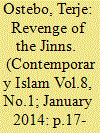| Srl | Item |
| 1 |
ID:
164026


|
|
|
|
|
| Summary/Abstract |
In this article I apply film theory as an analytic prism through which to examine the ritual mechanisms of a particular kind of Islamic exorcism (al-ruqya al-sharʿiyya). I show how these exorcisms operate as a ritual montage that conjures the absent presence of al-ghayb—a hidden world of power that only God can see in its totality and to which the possessed patients and the jinn spirits must succumb. These exorcisms thus provide healing, not in the sense of immediate “well-being” or “relief from pain” but in the sense of moral witnessing, an opportunity to testify to the limits of human seeing and action and to the ways in which invisible and divine forces give shape to the tangible world.
|
|
|
|
|
|
|
|
|
|
|
|
|
|
|
|
| 2 |
ID:
188969


|
|
|
|
|
| Summary/Abstract |
This article investigates in depth the practices of a Stockholm-based raqi. In the first section, the principles and methods of his version of ruqya (Islamic exorcism) are described: which Qur’anic passages he perceives as being most suitable to read in the cases of different afflictions, how he complement his reading with the use of his right palm to detect the possession, and his use of the “satanic meridians,” i.e., pressure points to use to facilitate the eviction of stubborn djinns. Later, the cases of five patients are discussed in order to shed light upon those who seek out his services. One particularly interesting example concerns a patient who regularly takes ruqya against sorcery. Despite the fact that she does not believe in sorcery herself, she considers ruqya more beneficial for her well-being than Western treatments. Next, the raqi’s perspective on psychotherapy and on mental illness in general are then presented. Finally, the problems of non-contextualized interviews versus ethnographic observations carried out as part of fieldwork for the purposes of gathering information are illustrated.
|
|
|
|
|
|
|
|
|
|
|
|
|
|
|
|
| 3 |
ID:
131476


|
|
|
|
|
| Publication |
2014.
|
| Summary/Abstract |
The point of departure for this article is a story about jinns taking revenge upon people who have abandoned earlier religious practices. It is a powerful account of their attempt to free themselves from a past viewed as inhabited by evil forces and about the encounter between contemporary Salafi reformism and a presumed disappearing religious universe. It serves to prove how a novel version of Islam has superseded former practices; delegitimized and categorized as belonging to the past. The story is, however, also an important source and an interesting entry-point to examine the continued relevance of past practices within processes of reform. Analyzing the story about the jinns and the trajectory of Salafi reform in Bale, this contribution demonstrates how the past remains intersected with present reformism, and how both former practices and novel impetuses are reconfigured through this process. The article pays attention to the dialectics of negotiations inherent to processes of reform and points to the manner in which the involvement of a range of different actors produces idiosyncratic results. It challenges notions of contemporary Islamic reform as something linear and fixed and argues that such processes are multifaceted and open-ended.
|
|
|
|
|
|
|
|
|
|
|
|
|
|
|
|
| 4 |
ID:
164025


|
|
|
|
|
| Summary/Abstract |
Spirits hold a central but ambivalent position in Indonesian political and social life. Pushed to the margins of public discourse in recent decades by modernism and Muslim piety, spirits remain key to the realm of the invisible or inscrutable (gaib) and continue to have a strong hold on the popular imagination in communities and on TV screens across the archipelago. One kind of spirit combines imagined potential and public ambivalence with particular force: jin spirits (also spelt jinn). Described in the Koran as real spiritual entities with an unfortunate habit of possessing humans, jin spirits are today also associated with heretical forms of Islam for many people with pious Muslim sensibilities and with backward superstition and evil magic for those with modern, secular sensibilities. Dealing with jin spirits, as a result, is always a careful negotiation with these cross-cutting sensibilities. This paper follows Kyai Muzakkin, the leader of an Islamic boarding school or pesantren in East Java, who insists that the one thousand jin spirits at his pesantren are real and effective “tools” at his disposal. I suggest that Kyai Muzakkin’s insistence on spirits as “tools” responds to the repressed and ambivalent reality of spirits in Indonesia. By turning tech-gnosis, the modern fascination with technology, into both ontological proof of and moral justification for the existence of spirits, Kyai Muzakkin harnesses the magic of modern technology – and of tele-technology in particular – in support of the reality of the invisible realm. While tele-technology thereby vindicates the reality of spirits and advocates for alternative ways of seeing Islam and the modern nation of Indonesia, I also argue that this vindication comes at a cost; namely the ambivalent re-inscription of visibility as proof of the real.
|
|
|
|
|
|
|
|
|
|
|
|
|
|
|
|